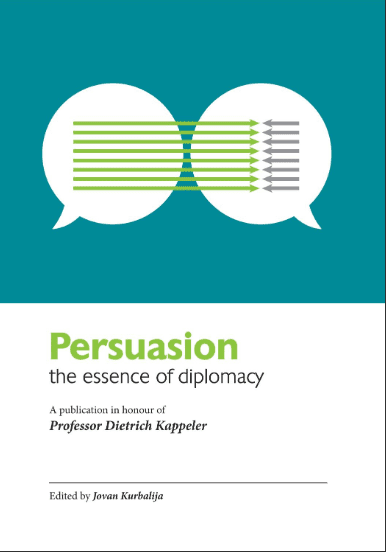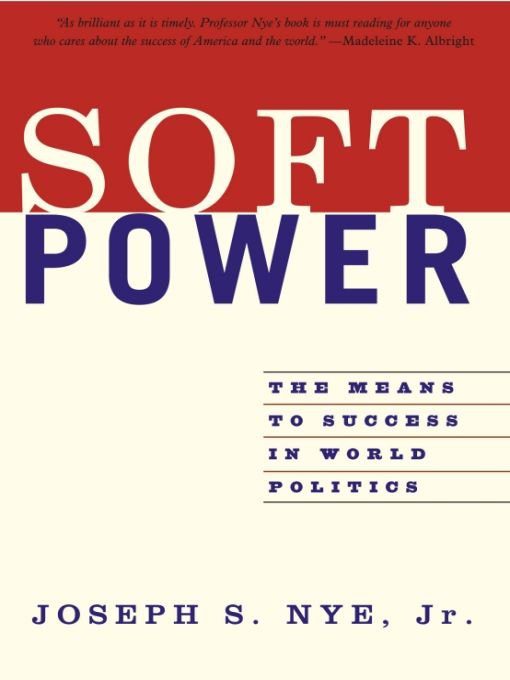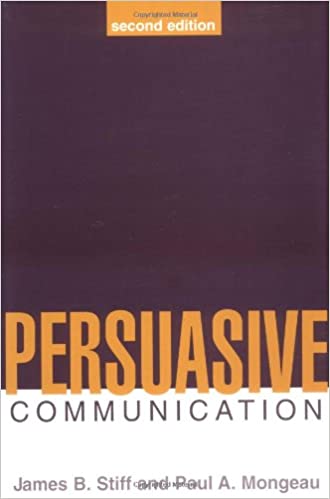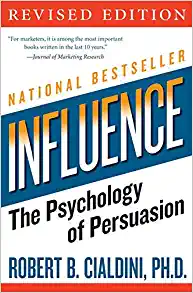Enablers emerge in a wide variety of forms from invention (the wheel, horse-riding) to social processes (educating women leads towards a drop in fertility). Persuasion is an important enabler of social change. Social media is an example where persuasion evolves from the individual to the collective. Through social media and crowd sourcing, collective intentionality can emerge. New forms of social, instead of individual, persuasion will emerge. The key criterion for their success is whether they facilitate adaptation to the fast pace of change in modern society.
Where war is the continuation of politics, we often see the diplomat as the avatar of the great general – or his precursor. Uplifting narratives tell us of heroic people who, through skill of arms or persuasion, shape extraordinary events and ‘get their way’. Persuasion is the individual’s triumph over persons and groups. Argument and convictions defeat ignorance. The individual is at the centre of the process: it is personal agency at its best.
I have a different view. I’d rather look at persuasion as a social phenomenon.
Let’s make one thing clear at the outset. In life, there are no dichotomies. It is never either/or. We have a river with many channels, spreading apart somehow at random, and converging lazily downstream.
Which is the river? Which is the arm? This does not matter. Pragmatically, the one best taking us to the goal is the ‘main’ channel. This may have gone on for thousands of years. Then a new technology emerges, and what we judged to be a shallow, treacherous, and impassable channel may become a new way down the river.
Persuasion may well be the work of personal agency, under certain circumstances. I’d argue that we’d better look at persuasion again. We need to take off the present eyeglasses named ‘personal agency’ and try on ‘social phenomenon’ for effectiveness.
Developments in life and human sciences justify this suggestion. These developments allow us to imagine living phenomena in novel ways.
Biological evolution and sociology
Biological evolution explains how change takes place in nature. It is both an individual and a collective phenomenon. What matters for the evolution of the population is not what change obtains in the individual, but how the change spreads through the population. If change ‘takes hold’ in the population, over generations the species will evolve. For all we know, the process is endogenous, and the outcome is undirected and unpredictable. The result is adaptation.
Sociology looks at change in society. Change occurs. Change reflects adjustment to the material context, but also the social reality we have construed. Looking at change from a distance, and using the language of agency improperly, we can speak of ‘macro-persuasion’.
The process of change is akin to a phase-transition we observe in physical sciences. Change occurs when intentionalities of individuals transmute into ‘collective intentionalities’. No longer does one individual change a few. Many change many. The many make change their own and act on it – the process of change has become endogenous. Their experience transforms the group and the process may grow exponentially. People dimly perceive this phase transition and have given it a name: social empowerment. As in biological evolution, whatever the original impulse, the outcome is undirected and unpredictable – it is adaptive.
Enablers as a source of social change
Enablers – ways of doing things and organising ourselves – are among the major causes of change. Someone learned to ride the horse, and as many imitated him, nomadism, but also long-distance raiding, emerged (I have shortened the process – in fact, innumerable small steps were involved). Democracy as a set of rules for a society emerged, and we had civilization of sorts.
Enablers are a product of the human mind. They are akin to genetic change as the source of phenotype variability. Users, not the inventor, decide on the purpose of the enabler. As a result, enablers are open-ended. Enablers empower, and are inherently unpredictable – just think of black powder.
Enablers are exquisite persuaders. Their strength is transformative experience, the pleasure of doing more with less, or doing something new. This is far more powerful as an agent of change than argument or conviction. Experience spreads enablers fast: we hardly notice this process. Just think of how children learn to speak.
Enablers are the most powerful sources of social change. They often act in indirect ways. Just a few examples: educate women and fertility drops precipitously. If human population is expanding, it is no longer from fertility, but from the fact that we live longer. The pill made recreational sex safe – and collaterally we have inched forward in solving the population problem – this in two generations. Better cooking stoves may help mitigate anthropogenic carbon: billions of women will be thankful for taking suffocating smoke from their lungs. No one invented markets as an institution. They emerged slowly from the mists of time. Markets are among the great enablers – that is why it is difficult to fight them, even when they do not suit participants’ intentions.
Cognitive science and social psychology
Cognitive science resolutely casts doubt on the received model of personal agency in achieving macro-change (and even micro-change). Human brains are complex but seriously prone to illusion. Fallacies and biases infect reflexive and reflective thinking. A need for individual self-affirmation leads humans to see themselves as unchanging and coherent, when we are far from it. If need be, we will fabulate to sustain the self. What is described as ‘will’ turns out to be more akin to conscious commentary forever running slightly behind unconscious action. Rather than a well-designed structure, the conscious and unconscious mind is a rickety, jury-rigged contraption. From the population point of view, the system works: in 100 000 years we have made long strides. It was a story of successful adaption, rather than directed change.
At the micro-persuasion level, social psychology explains the behavior of the person in the social situation. It explores our nature as social beings. Far from being autonomous individuals bumping into each other in some form of Brownian motion, we continuously and subtly persuade each other and adapt in the process – mostly unconsciously. Change is a social phenomenon. Change has no recognizable individual origin, and the outcome is undirected and unpredictable. It is adaptive.
We seem to have made a discovery – we may have found a different river channel, and one which, unbeknown to ourselves, carries much water of social change. Change is also a social phenomenon and not only or primarily the result of individual agency. Change in society does not come from without – change emerges from within.
The process of empowerment
Is this a discovery? Possibly it is just that a narrative has been found for something humanity has known and used all along, but never narrated. In particular, we have a name for the process of social change: empowerment. It describes the transition from individual to collective intentionality and the moment when society starts to change itself. It is the moment when the social group adopts change – the newly created enabler – as its own and runs with it.
Let me revert to the analogy of the river: we have discovered a new channel. Admittedly, the realisation that the old channel had treacherous shoals and rapids, which made navigation adventurous, may have spurred on the search. We did not perceive the dangers: we only saw the saved and ignored the drowned.
Technological and culture create enablers all the time. While waiting for enablers to do their work: can we facilitate empowerment? We are learning how to speed up the process of empowerment. Economic and community development practices are in the forefront. When empowerment succeeds, the impact is stupendous. Positive deviance for instance builds on the basic idea that we can cleverly facilitate empowerment.
Information technology both facilitates and documents social interaction within a group. It explodes the physical limitations of the group. Information technology facilitates the emergence of new social groups – think of the common purpose that unites the editors of Wikipedia entries.
Information technology is the greatest enabler since the horse (my prejudice). Nothing is empowering people like their ability to record, process, and transmit information to others, hereby bypassing some obvious failures of the brain. No replacement, so far, but far more reliable than memory, and able to act at a distance.
Information technologies facilitate and document social interaction. We can use information technologies to track change. Information technologies may assist us in documenting empowerment as it takes place. Information technologies may even facilitate empowerment.
Social networks have become the rage. At the moment, they tend to be mostly gossip – a necessary aspect of sociality. Clever use of social networks may create what I’d call social – as opposed to individual – persuaders. They may become a new way of obtaining collective intentionality.
This is not going to be easy.
Crowd-sourcing or industry-wide sourcing has become a significant way of getting pointers towards the improvement of products (materials and processes are a different matter). The supply side of change is becoming public. It is bottom-up – and hugely successful. Whittling down the abundance of ideas is the challenge. So far selection has remained a top-down process – and internal to the firm (before confronting the public process of market selection, that is). Transformation of the idea into a product requires industrial organisation yielding the uniformity needed to allow for industrial mass production.
Social empowerment transforms individual intentionalities into a collective one. So far society has tended to use the top-down, directive approach in order to speed up the process. Dreading loss of control that goes with empowerment, the elite has used fear or incentives to turn individuals into agents. This process works against empowerment. Ideology mitigated the process. Inevitably over time, top-down choices and ideology created rigidities. Disconnect and social unrest ensued as the social and material context changed.
Collective intentionality
How do we achieve collective intentionality without resorting to top-down selection and direction? Village meetings work well if the village is a single social group. As soon as the size of the group becomes too large or we have nestled groups, creating collective intentionality becomes difficult.
My practical conjecture is that information technology may be of assistance here. We are just at the beginning. Think of the spontaneous way of Wikipedia. Simple operational rules allow the aggregation of rules. Respect is the currency within the group. Peer review within the group reduces the abundance of opportunities. Crowd-reviewing has now been added. Other options and features may be added.
On the political scene, the instrument of petition is on the rise. Citizens can formulate relatively well-articulated propositions. Online voting rapidly whittles down the options. This is a rough-and-ready way. Quantity replaces quality.
Until 1250, humans paid little deliberate or deliberative attention to the concept of material reality as quantifiable. We changed the way of doing things. We measured everything, from time to space, to colours, and look where this way of doing things has taken us.
Quantifying social reality
The time may have come to make a further leap and quantify social reality. The democratic vote – one person, one vote – is a slightly distasteful and controversial precursor. The elites never took kindly to it. Information technologies may allow us to move towards the quantification of social reality on a broad scale, just as we have successfully quantified material reality.
When group behaviour is the objective, individual diversity no longer becomes an issue. We no longer need Gleichschaltung –in many instances nudging, rather than coercion and control suffices. In fact, we need to encourage it as the pool from which change emerges. This is an immense relief to me, and necessary for the system to function. Darwin said: ‘It is not the strongest of the species that survives, nor the most intelligent that survives. It is the one that is the most adaptable to change.’ Paying attention to change is the precondition for surviving and flourishing.
In this paradigm, we accept each other because, and not despite, human diversity. What a change in attitude! Information reality may facilitate this leap of attitude by making empowerment easier. Empowerment is what changes us, and makes us feel human.











